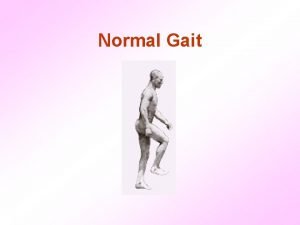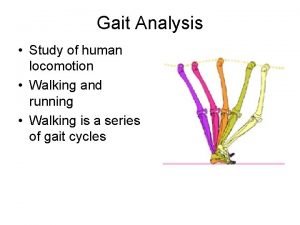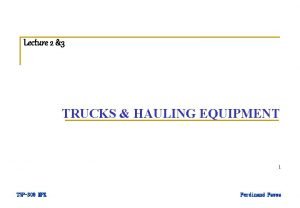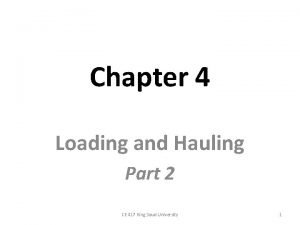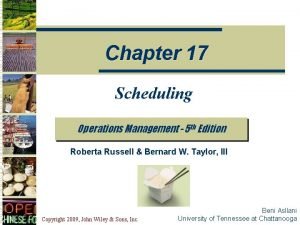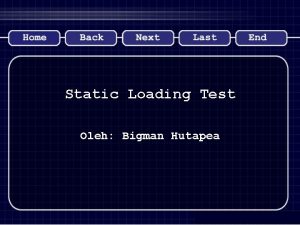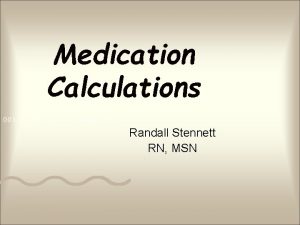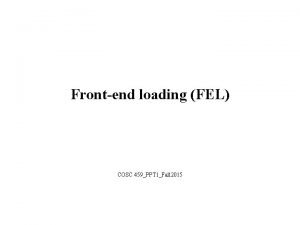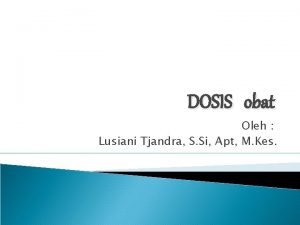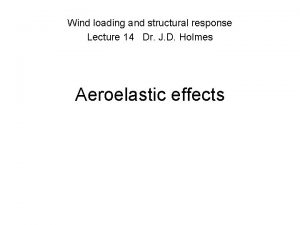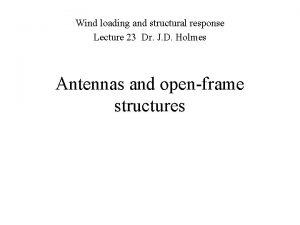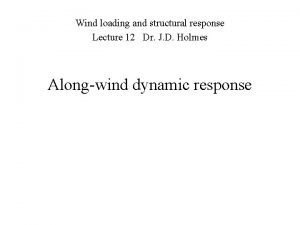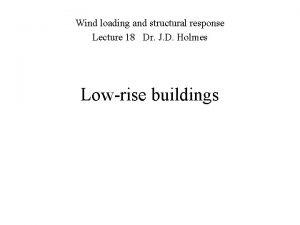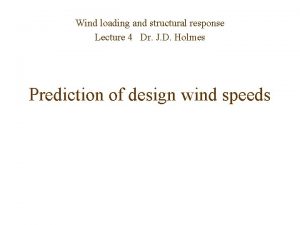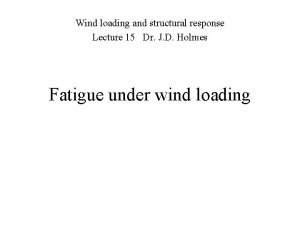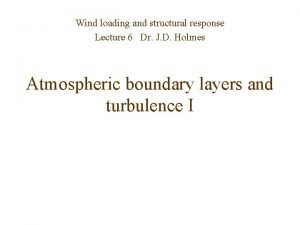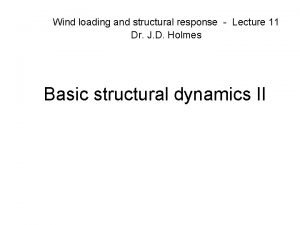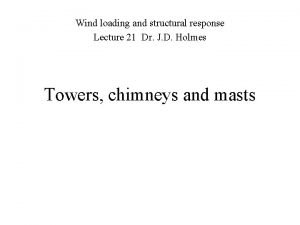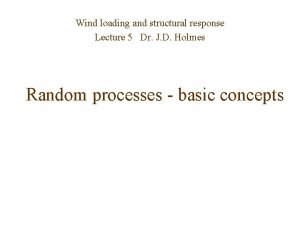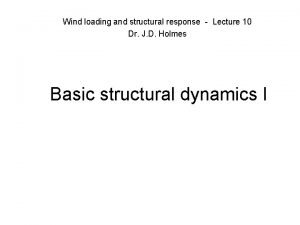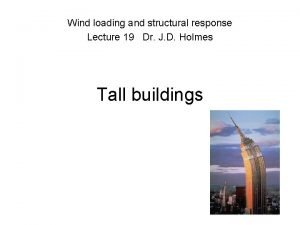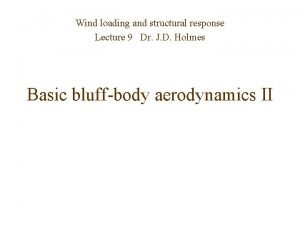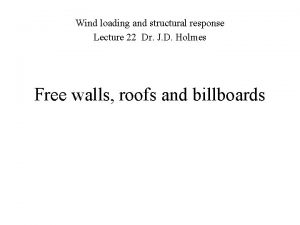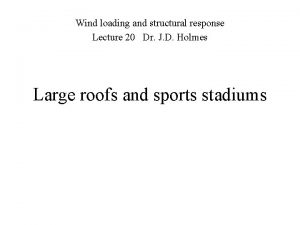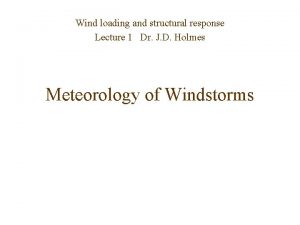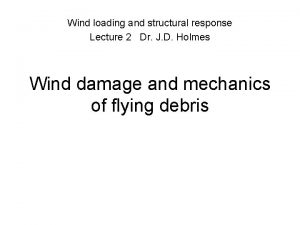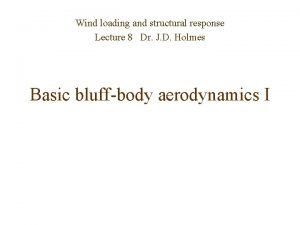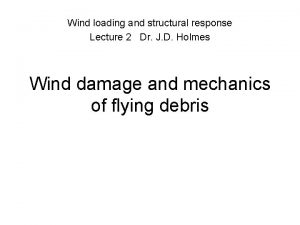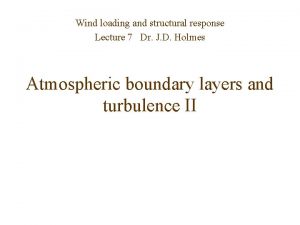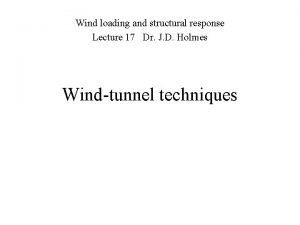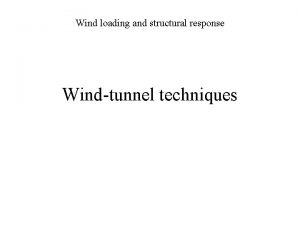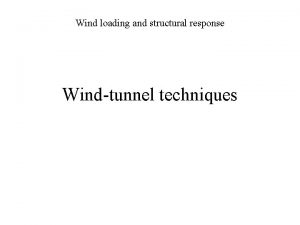Wind loading and structural response Lecture 13 Dr













![Effective static loading distributions Mean component p(z) = [0. 5 a Uh 2] Cp Effective static loading distributions Mean component p(z) = [0. 5 a Uh 2] Cp](https://slidetodoc.com/presentation_image_h2/a61bd10d4722714bd312209fa6cc6d23/image-14.jpg)



















- Slides: 33

Wind loading and structural response Lecture 13 Dr. J. D. Holmes Effective static loading distributions

Effective static loading distributions • Static load distributions which give correct peak load effects under fluctuating wind loading Separately calculate e. s. l. d s for : • mean component • background component • resonant components • Generally e. s. l. d. s depend on load effect (e. g. bending moment, shear)

Effective static loading distributions Influence coefficient : Value of a load effect as a unit load is moved around a structure :

Effective static loading distributions Influence coefficient : Value of a load effect as a unit load is moved around a structure :

Effective static loading distributions Influence coefficient : Value of a load effect as a unit load is moved around a structure :

Effective static loading distributions Influence coefficient : Value of a load effect as a unit load is moved around a structure :

Effective static loading distributions Influence coefficient : Value of a load effect as a unit load is moved around a structure :

Effective static loading distributions Influence coefficient : Value of a load effect as a unit load is moved around a structure :

Effective static loading distributions Influence coefficient : Value of a load effect as a unit load is moved around a structure :

Effective static loading distributions Influence coefficient : Value of a load effect as a unit load is moved around a structure :

Effective static loading distributions Influence coefficient : Value of a load effect as a unit load is moved around a structure :

Effective static loading distributions Influence coefficient : Value of a load effect as a unit load is moved around a structure :

Effective static loading distributions Influence coefficient : Value of a load effect as a unit load is moved around a structure : Ir(z) z For a distributed load p(z) , r =
![Effective static loading distributions Mean component pz 0 5 a Uh 2 Cp Effective static loading distributions Mean component p(z) = [0. 5 a Uh 2] Cp](https://slidetodoc.com/presentation_image_h2/a61bd10d4722714bd312209fa6cc6d23/image-14.jpg)
Effective static loading distributions Mean component p(z) = [0. 5 a Uh 2] Cp on a tower : f (z) = [0. 5 a U(z)2] Cd b(z) (per unit height)

Effective static loading distributions Background (quasi-static) component (Kasperski 1992) pr(z) : correlation coefficient between the fluctuating load effect, and the fluctuating pressure at position, z

Effective static loading distributions Background (quasi-static) component Consider a load effect r with influence line Ir(z): Instantaneous value of r : r(t) = p(z, t) = fluctuating pressure at z L is length of the structure Mean value of r :

Effective static loading distributions Background (quasi-static) component Standard deviation of r : (background) (Lecture 9) Expected maximum value of r : Distribution for maximum response : p. B(z) = g. B pr (z) p (z)

Effective static loading distributions Background (quasi-static) component Check :

Effective static loading distributions Background (quasi-static) component Discrete form of pr : This form is useful when using wind-tunnel data obtained from area-averaging over discrete measurement panels Standard deviation of load effect :

Effective static loading distributions Example (pitched free roof) : (Appendix F in book) 2 h 22. 5 1

Effective static loading distributions Wind-tunnel test results : Correlation coefficient = -0. 17 +0. 46, (0. 35) 0. 60, (0. 20) - mean, std. dev. Cp’s +0. 03, (-1. 90) peak Cp’s +2. 53, (-0. 65)

Effective static loading distributions Mean drag force : Influence coefficients : Panel 1 : +h Panel 2 : -h Mean drag force : D = (0. 46) qh (+h) + (-0. 60) qh (-h) = 1. 06 qh (h) qh is the reference mean dynamic pressure at roof height

Effective static loading distributions Standard deviation of drag force : D = qh [(0. 35)2 (+h)2+ (0. 20)2(-h)2 + 2(-0. 17). (0. 35) (0. 20)(+h)(-h)]1/2 = 0. 432 qh h qh is the reference mean dynamic pressure at roof height Peak drag force : = 1. 06 qh h + 4 0. 432 qh h = 2. 79 qh h assuming a peak factor g of 4

Effective static loading distributions Effective pressures for maximum drag force : Covariance between p 1(t) and drag D(t) : [ . (h) + (-h)] = qh 2 h [(0. 35)2 - (-0. 17)(0. 35)(0. 20)] = (0. 134) qh 2 h Correlation coefficient : = 0. 886 Pressure on panel 1 when D is maximum : = qh [ Cp 1 + g p 1, D Cp 1] = qh [(0. 46) + 4 (0. 886) (0. 35)] = 1. 70 qh

Effective static loading distributions Effective pressures for maximum drag force : Covariance between p 2(t) and drag D(t) : [ . (h) + (-h)] = qh 2 h [ (-0. 17)(0. 20)(0. 35)- (0. 20)2 )] = -(0. 052) qh 2 h Correlation coefficient : = -0. 602 Pressure on panel 2 when D is maximum : = qh [ Cp 2 + g p 2, D Cp 2] = qh [(-0. 60) + 4 (-0. 602) (0. 20)] = -1. 08 qh

Effective static loading distributions Effective pressures for maximum drag force : Pressure coefficients corresponding to maximum drag : -1. 08 +1. 70 -1. 08 Check : maximum drag force : +1. 70 = (1. 70) qh (+h) + (-1. 08) qh (-h) = 2. 78 qh(h) (previously 2. 79 qh(h) )

Effective static loading distributions Effective pressures for maximum lift force : Pressure coefficients corresponding to maximum uplift force: -0. 90 -0. 73 2 -0. 90 -0. 73 1

Effective static loading distributions Effective pressures for minimum lift force : Pressure coefficients corresponding to minimum uplift force: (maximum down force) -0. 30 +1. 65 2 -0. 30 +1. 65 1

Effective static loading distributions Resonant load distribution : f. R (z) = g. R m(z) (2 n 1)2 1 (z) g. R is peak factor for resonant response m(z) is mass per unit length n 1 is first mode natural frequency (= a) is the standard deviation of the modal coordinate 1 (z) is the mode shape for the first mode of vibration where, x(z, t) = j aj (t) j (z) (modal analysis)

Effective static loading distributions Combined load distribution : Wback and Wres are weighting factors Check : (correct expression)

Effective static loading distributions Example : Effective static load distributions for end reaction and bending moment on an arched roof (no resonant contribution): 45 - + C Cp =0. 5 R Extreme load distribution for the support reaction, R Extreme load distribution for the bending moment at C Gust pressure envelope

Effective static loading distributions Example : Effective static load distributions for base bending moment on a tower :

End of Lecture 13 John Holmes 225 -405 -3789 JHolmes@lsu. edu
 Static vs dynamic class loading
Static vs dynamic class loading Perbedaan granit double loading dan single loading
Perbedaan granit double loading dan single loading Medical term for normal gait
Medical term for normal gait Trendelenburg gait treatment
Trendelenburg gait treatment 01:640:244 lecture notes - lecture 15: plat, idah, farad
01:640:244 lecture notes - lecture 15: plat, idah, farad Structural dynamics of deep water offshore wind turbines
Structural dynamics of deep water offshore wind turbines Kurshalter
Kurshalter Natural response and forced response
Natural response and forced response What is natural response
What is natural response Primary immune response and secondary immune response
Primary immune response and secondary immune response Factors affecting haulers productivity
Factors affecting haulers productivity Health and safety of injection moulding
Health and safety of injection moulding Loading and hauling
Loading and hauling Scheduling rules operations management
Scheduling rules operations management Azure sql data warehouse
Azure sql data warehouse Static vs dynamic linking
Static vs dynamic linking Mutoharoh
Mutoharoh Static loading test adalah
Static loading test adalah Size separation mode of applied are
Size separation mode of applied are Army skl
Army skl Film hopper in radiography
Film hopper in radiography Pemberian obat oral
Pemberian obat oral Task loading orm
Task loading orm Nmos inverter with enhancement load
Nmos inverter with enhancement load Loading dose calculation example
Loading dose calculation example Hepatic extraction ratio formula
Hepatic extraction ratio formula Site:slidetodoc.com
Site:slidetodoc.com Fel front end loading
Fel front end loading Forward vs backward scheduling
Forward vs backward scheduling Loading dose units
Loading dose units Loading dose units
Loading dose units Dynamic class loading
Dynamic class loading Boorzalf
Boorzalf Dosage regimen definition
Dosage regimen definition


